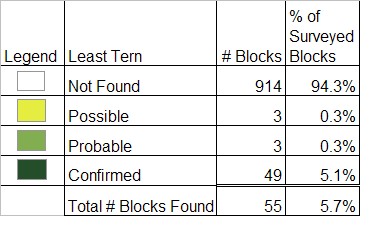Find a Bird - BBA1
Breeding Bird Atlas 1 Species Accounts
Least Tern
Sterna antillarum
Egg Dates
May 23 to July 28
Number of Broods
one; may re-lay if first attempt fails.

Although accurate historical data is lacking, the Least Tern is thought to have long been a common to abundant nester in Massachusetts. By the end of the nineteenth century, however, the species had been nearly extirpated from its entire range. After the turn of the century, only a few small pockets of nesting birds survived on remote refuges in southeastern Massachusetts. Under complete legal protection after 1918, the species recovered rapidly. In 1923, Forbush estimated a state population of 300 birds as far north as Duxbury. In an incomplete census in 1935-1936, Hagar raised this estimate to 830 birds.
From 1974 onward, the Massachusetts Audubon Society and the Massachusetts Division of Fisheries and Wildlife have made concerted efforts to track the Least Tern population. During the Atlas period, Least Terns were reported from approximately 54 stations along the Massachusetts coast, primarily at river mouths and along barrier islands and beaches. Nesting occurs mostly from Cape Cod north to Scituate and on the islands of Nantucket and Martha’s Vineyard. The species is much less frequent about the predominantly rocky shores of Buzzards Bay and Massachusetts Bay between Cohasset and Rockport and is entirely absent inland.
The mean population, conservatively estimated over the five-year period 1974 to 1979, was 1,300 pairs (range 800 to 1,734). Subsequently, the estimated population trend has been upward, reaching 2,040 pairs at 40 stations in 1980 and 2,415 pairs at 42 stations in 1984. Some of the increase is definitely a reflection of more thorough census coverage. However, aggressive protective programs and public educatoin have likely resulted in a real increase as well. Year-to-year numbers at individual colonies fluctuate widely as a result of habitat changes and human disturbance.
In spring, returning Least Terns are on the Massachusetts beaches by mid-May, though actual commencemnet of nesting activities is typically delayed until the third week of May and sometimes even to mid-June, on account of weather conditions. The Least Tern is a classic opportunistic nester that capitalizes on ephemeral nesting conditions. The preferred nesting habitat—expansive sandy or pebbly beaches just slightly above the high tide line—is very unstable and subject to dramatic yearly change due to storms. The deposition of dredge spoil upon beaches provides excellent nesting substrate and has been a positive factor for the species. Unlike most terns, Least Terns do not prefer on-island sites, and most colonies are actually situated along mainland or barrier beaches. As a result, they are especially vulnerable to mammalian predator raids and human disturbance.
Courtship involves high-speed ceremonial flights and strutting. Copulation is accompanied by head-turning displays by the male, who holds a fish and presents it to the female immediately after consummation. The birds are highly nervous and defensive of nests and chicks, attacking upon any provocation, with alarmed colonies flying up in group defense. Dubbed in some quarters as “Little Strikers,” Least Terns rarely actually strike but instead drop excrement upon intruders with accuracy.
The most frequently given vocalization is a shrill two-note kidic-kidic or kidee-kidee. Alarmed birds utter a sharp kip-kip-kip at varying speeds and intensities, depending upon their emotional state. When attacking intruders, individuals give an emphatic rasping zzraap.
The nests are shallow scrapes in the sand, fashioned by the female. Numerous scrapes are often made before a final site is selected. Clutches of one to three (usually two) cryptic eggs are laid. The peak of laying activity is usually June 5 to June 15. If the terns are disturbed by predators or storms, they will stubbornly renest into late July. One egg is laid each morning until completion of the clutch. The incubation period is 20 to 23 days, with both sexes involved. In one Massachusetts study of eggs from total nests, 60 percent hatched, 27 percent were lost to predators, 11 percent were abandoned, and 2 percent were washed out. The eggs hatch asynchronously, with incubation continuing in most cases until the last egg is hatched.
The precocial chicks remain at the scrape for only about a day, during which they are brooded constantly. After this, the chicks run freely over the beach, sometimes seeking out the scant shade of beach detritus and Dunegrass. Chicks are extremely cryptic and flatten themselves on the sand upon the warning of adults. The coloration and pattern of the young, even of siblings, vary dramatically. They fly 28 days after hatching and are fed bait fish for an unknown period of time before they start foraging for themselves. The average fledging success in Massachusetts from the late 1960s to early 1980s was .6 young per pair.
Departure from Massachusetts occurs very soon after the young are flying, and Least Terns are usually difficult to find after September 1. The duration of the family bond is unknown. The wintering grounds are along the coast of South America from Colombia to eastern Brazil.
The Least Tern is listed as a species of special concern in Massachusetts.
Map Legend and Data Summary
Atlas 1 data collected from 1975-1979


Note: locally common in small colonies on pebbly sand beaches; apparently increasing
Erma J. Fisk



